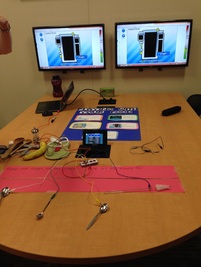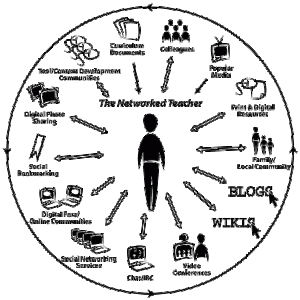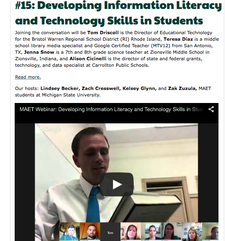Transforming through MAET: Bringing the HOW and WHY to my Classroom
Synthesis Essay
I had never considered myself to be a “Tech Guru.” I was never the one to have a knack for trouble-shooting, to stand in line for the newest iPhone, or to tinker with technology. I stayed in my technology comfort zone and always pointed someone in need far away from me. So, when I was hired as a Spanish teacher in a 1:1 school with student computers, I felt lost. I was expected to take advantage of the technology in front of me, but I didn’t know where to start. Technology use during my first year of teaching consisted of using Google Docs instead of printed paper and putting a few lessons up on our Learning Management System (LMS). I was frustrated that I had such a wonderful tool in front of me and no idea how to use it effectively. I decided in March 2014 to apply to Michigan State University’s Master’s of Educational Technology (MAET) program.
Choosing this program was an easy decision for me. I completed my undergraduate studies at Michigan State and started my Master’s journey during my student-teaching internship through MSU. During this year-long internship, I took two Master’s courses (TE 801 and TE 803). These courses focused on teaching theories, communication strategies, classroom management, and student engagement. I wanted to continue my education at Michigan State because of the quality programs offered through its College of Education. I was interested in the MAET program, in particular, because I hoped it would provide me with useful resources for my 1:1 classroom. I completed two MAET summer sessions as a hybrid: my class and I met on campus for two weeks and then online for four weeks. This structure allowed me to get to know my peers and professors well and did not interfere with my teaching schedule. The course work during both summers was intensive, but at the end of each session, I was excited to apply my new knowledge to the classroom.
When I first applied to the MAET program, I was afraid that this was just going to be a very expensive technology conference. I crossed my fingers that this was not going to be a long string of apps, websites, and tech tools. I needed more. I hoped to learn HOW to implement technology and WHY technology will change my teaching.
Choosing this program was an easy decision for me. I completed my undergraduate studies at Michigan State and started my Master’s journey during my student-teaching internship through MSU. During this year-long internship, I took two Master’s courses (TE 801 and TE 803). These courses focused on teaching theories, communication strategies, classroom management, and student engagement. I wanted to continue my education at Michigan State because of the quality programs offered through its College of Education. I was interested in the MAET program, in particular, because I hoped it would provide me with useful resources for my 1:1 classroom. I completed two MAET summer sessions as a hybrid: my class and I met on campus for two weeks and then online for four weeks. This structure allowed me to get to know my peers and professors well and did not interfere with my teaching schedule. The course work during both summers was intensive, but at the end of each session, I was excited to apply my new knowledge to the classroom.
When I first applied to the MAET program, I was afraid that this was just going to be a very expensive technology conference. I crossed my fingers that this was not going to be a long string of apps, websites, and tech tools. I needed more. I hoped to learn HOW to implement technology and WHY technology will change my teaching.
Focusing on the HOW
The 2014 summer cohort (courses CEP 810, CEP 811, CEP 812) was extremely motivational and inspiring. Every day, I was challenged with new information and my mind was constantly running with new ideas.
This first year focused on HOW educational technology can impact teaching.
The 2014 summer cohort (courses CEP 810, CEP 811, CEP 812) was extremely motivational and inspiring. Every day, I was challenged with new information and my mind was constantly running with new ideas.
This first year focused on HOW educational technology can impact teaching.
|
Coming from a 1:1 school, I wanted to use computer technology everywhere. I knew I didn’t want to use technology for the sake of using technology, but that is exactly what I was doing. Learning about Technological Pedagogical Content Knowledge (TPACK) changed my whole outlook on technology. TPACK emphasizes the importance of knowing how technology interacts with content knowledge and pedagogy (www.tpack.org). A teacher needs to find what technology will best aid the teaching of a specific content area. This technology does not have to be electronic; technology comes in many forms. A pencil and paper is a technology; post-it notes are technology; computer apps are technology; etc. During this year 1 cohort, I reexamined my teaching. How was I using technology to aid my pedagogy? What technologies are better suited to teach a certain concept? What affordances and constraints did a technology have on my lesson? TPACK reaffirmed that I should not be using computer technology just for the sake of using technology. The technology I chose should reinvent and modify my teaching to transform student learning. I had to question each technology and find the “sweet spot” where technology, pedagogy, and content knowledge each complimented each other.
Another eye-opening moment was learning of the Maker Movement. The Maker Movement challenges people to explore and tinker with technology to create something new or fun. (http://makerfaire.com) Maker Faires have started all around the country to promote this movement and provide a space to play. The Maker Movement and Maker Faires answered my question of HOW in regards to student inquiry. I wanted students to explore, find answers on their own, and not be afraid to fail. The Maker Movement encourages students to find a solution or answer through play, trial and error, and hands-on experimentation. Giving students this time to process, play with the material, and ask themselves questions to get to the answer is exactly what inquiry-based learning should look like in my classroom. Through the Master’s of Educational Technology program, my classmates and I put together a Maker Faire at the MSU library, through which I learned a lot about learning. I observed participants who were easily frustrated that there was not a user manual or set of directions. I watched fearless participants take on a trial-and-error approach, not afraid to look stupid or try the wrong thing. I saw participants hesitate at first before diving into solving the problem hands on. I felt that these Maker Faire participants represented the different types of learners in my classroom. In fact, I could name former students who would have acted in ways similar to these participants. I wondered what effect this would have on learners to be able to tinker and play early in their education. Although I have not found a way to exactly bring the Maker Movement to the Spanish classroom, I use this theory of student-questioning, trial-and-error, and play as an effective means to learning Spanish. The last big question answered in this summer cohort was “HOW do I possibly keep up with ever-changing technology?” I learned so much during this six-week intensive course, and I did not want the learning to end. I did not know where to find new technology tools or ideas. This course stressed the importance of a Personal Learning Network (PLN). I created a professional Twitter and followed other Spanish teachers, educational professionals, and Spanish news sites. I also participated in my first Twitter chat. I realized that I could easily keep in contact with my classmates from the MAET program, other big names in education, and authentic resources from Spanish-speaking countries. I followed blogs and reached out to others in the field with questions. Now, I read through my Twitter feed daily, retweeting or favoriting new tools or activities. My students have asked me plenty of times, “Where did you find this website/activity/song/etc.?” and don’t believe me when I say, “Twitter!” My PNL is my most important resource for staying up-to-date with technology and ideas and, therefore, keeping my lessons fresh. |
Now that I knew the HOW, I wanted to know WHY…
In year 1, we focused on HOW technology can be used for learning, while the year 2 2015 summer cohort (courses CEP 800, CEP 815, CEP 822) focused on WHY students learn and respond from one technology more than another.
In year 1, we focused on HOW technology can be used for learning, while the year 2 2015 summer cohort (courses CEP 800, CEP 815, CEP 822) focused on WHY students learn and respond from one technology more than another.
|
First, we looked into various learning theories: behaviorism, constructivism, cognitivism, and cognitive development. I have learned WHY using different technologies with behaviorism, constructivism, and cognitivism traits during lessons is necessary to meet the different needs of students. Some students respond best to a gamified lesson, while others prefer to transfer prior knowledge of English grammar or culture to Spanish and build on that. During the year 2 cohort, my classmates and I led a Webinar with experts in the field of content literacy, discussing how technologies can be modified to reach the needs of all students and can offer differentiation to incorporate all learning theories and styles.
Studying misconceptions answered another WHY question: “WHY do students think that when I have never taught that?” Students all come into our classes with prior knowledge. Some of this prior knowledge can lead to misconceptions and misunderstandings. As a teacher, I realize I need to find out what misconceptions students have of the Spanish language and Spanish speakers before teaching a new concept. I need to confront misconceptions head-on and force students to challenge their understanding to ensure they learn the correct material. This concept was highlighted when my MAET group members and I studied the misconceptions surrounding the Cloud. I realized that people filled in the blanks in their minds to create a complete story or explanation. The people we interviewed all had different ideas of the Cloud, its uses, and Internet safety. They created their understanding from their personal experiences, what they had heard on the television or from friends, or read about on the Internet or in the news. This made me think of what my students have created on their own and how that affects their learning of concepts in class. Paired with student-inquiry lessons, technology allows students to confront their misconceptions by challenging their prior knowledge. Finally, I wondered, “WHY do students forget information so quickly?” In the year 2 cohort, we discussed making ideas “sticky” so they are retained in students’ long-term memory. A way to make ideas sticky is to let students ask the questions. Student-led inquiry will force students to confront their misunderstandings or misconceptions and ask questions to find the truth. 1:1 technology provides students the opportunity to use computers to find answers to their questions and work at their own pace. Furthermore, I have found that interactive programs improve engagement, which makes ideas “stick” with students. |
Bringing the HOWs and WHYs together…
Teachers have been trained to think about the future, constantly planning for the weeks, and even years, ahead. Yet, taking time to reflect on the past is a valuable lesson too. The Capstone course required me to take pause and contemplate HOW I use technology and WHY. I know I am a more competent teacher because of the MAET program. Inspired by my Master’s work, I have implemented many new strategies in my classroom. First, I began a Genius Hour project, focusing on student-inquiry and confronting misconceptions as students researched any topic of Spanish culture. Second, I have used Twitter and my PLN to learn about instant-feedback programs to use with my students. Some are more gamified, like Kahoot or Quizizz, while others allow for individualized feedback and praise, like Nearpod or GoFormative. Finally, I have reflected on why these technology changes are so important to my classroom. Technology allows for differentiation, variety in lessons, and a voice for every student. Additionally, teaching students to use technology efficiently will help them to become productive 21st century learners. Allowing students to play with technology and learn to question the information and misconceptions they see online will prepare them for the future.
Through my reflection in the Capstone course, I realize how much I have loved learning. I started this journey to learn HOW to use technology effectively and WHY to choose certain technologies for each lesson. When my Master’s is complete and learning is no longer required, I hope to keep acquiring new technology skills and never become too comfortable.
The HOWs and WHYs of the future…
Finally, the Capstone course (CEP 807) has forced me to think about my future and HOW and WHY I will use all this knowledge aside from my classroom. Although I am happy teaching right now, I hope that in the future, I can become a technology integration specialist to help a corporation transition to a 1:1 district. I feel confident I could show other teachers the importance of knowing HOW to choose the right technology and WHY technologies impact student learning. Knowing the HOWs and WHYs have certainly transformed my teaching, and I want to share that with other teachers.
Teachers have been trained to think about the future, constantly planning for the weeks, and even years, ahead. Yet, taking time to reflect on the past is a valuable lesson too. The Capstone course required me to take pause and contemplate HOW I use technology and WHY. I know I am a more competent teacher because of the MAET program. Inspired by my Master’s work, I have implemented many new strategies in my classroom. First, I began a Genius Hour project, focusing on student-inquiry and confronting misconceptions as students researched any topic of Spanish culture. Second, I have used Twitter and my PLN to learn about instant-feedback programs to use with my students. Some are more gamified, like Kahoot or Quizizz, while others allow for individualized feedback and praise, like Nearpod or GoFormative. Finally, I have reflected on why these technology changes are so important to my classroom. Technology allows for differentiation, variety in lessons, and a voice for every student. Additionally, teaching students to use technology efficiently will help them to become productive 21st century learners. Allowing students to play with technology and learn to question the information and misconceptions they see online will prepare them for the future.
Through my reflection in the Capstone course, I realize how much I have loved learning. I started this journey to learn HOW to use technology effectively and WHY to choose certain technologies for each lesson. When my Master’s is complete and learning is no longer required, I hope to keep acquiring new technology skills and never become too comfortable.
The HOWs and WHYs of the future…
Finally, the Capstone course (CEP 807) has forced me to think about my future and HOW and WHY I will use all this knowledge aside from my classroom. Although I am happy teaching right now, I hope that in the future, I can become a technology integration specialist to help a corporation transition to a 1:1 district. I feel confident I could show other teachers the importance of knowing HOW to choose the right technology and WHY technologies impact student learning. Knowing the HOWs and WHYs have certainly transformed my teaching, and I want to share that with other teachers.
| capstonesynthesisessay.pdf | |
| File Size: | 142 kb |
| File Type: | |






